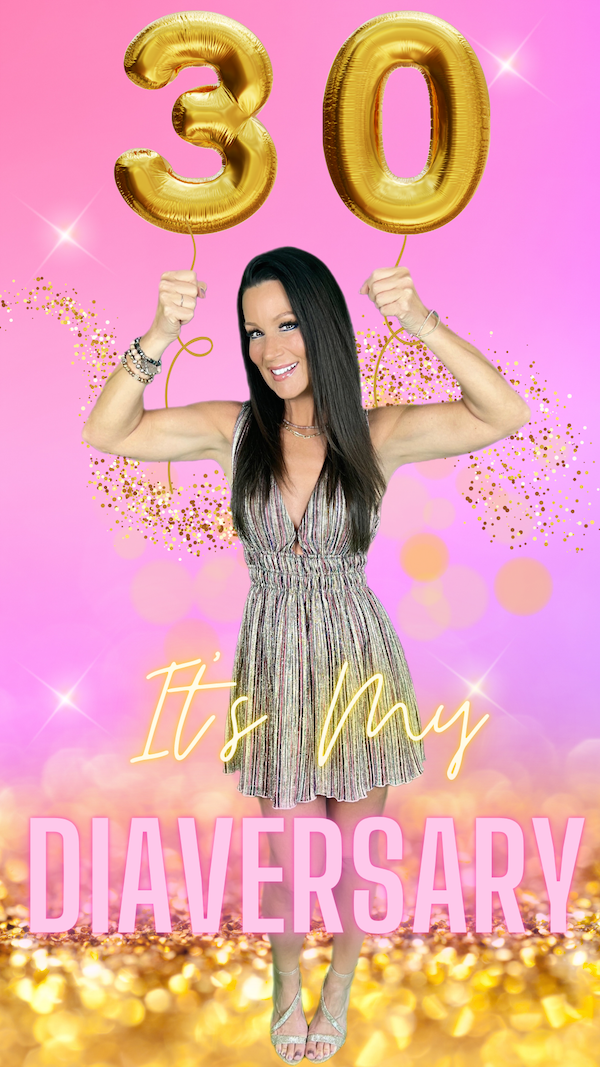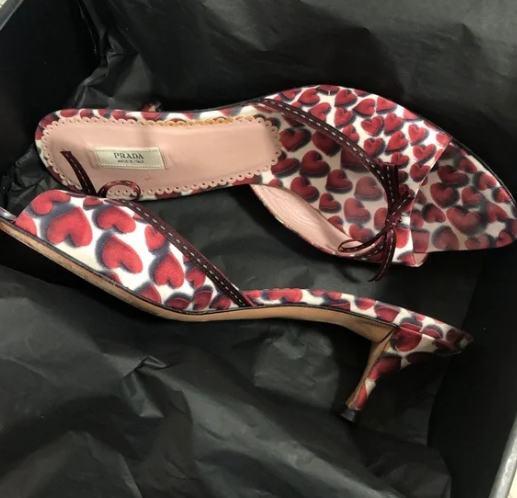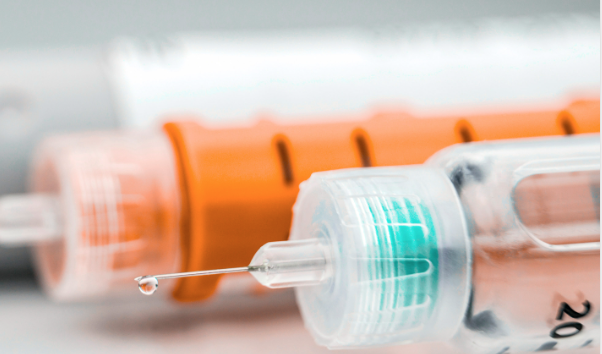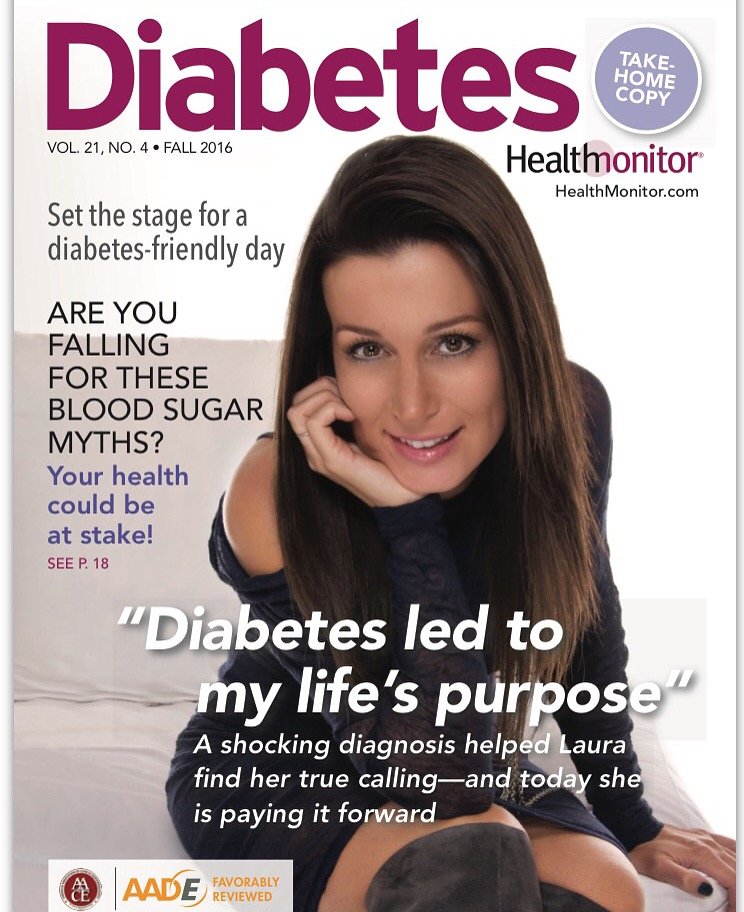My 30th Diaversary
Celebrating Three Decades of Living with Type 1 Diabetes
30 Years. 10,950 Days. 262,800 Hours. 15,778,800 Minutes. 946,728,000 Seconds.
However you look at it, it’s a really long time!
During my senior year of college, I was sitting in my sorority house (ADPI) at the University of Rhode Island (Go Rhody), waiting to eat dinner when suddenly my tongue and lips went numb—it felt like pins and needles on the inside of my mouth. I asked my sorority sisters at the table if anyone had ever experienced that sensation before and they all looked at me as though I were crazy, so I quietly ate my dinner, eventually felt better, and carried on.
That strange tingling in my mouth repeated itself often throughout the rest of my final year of school. I never knew what overcame me, but I knew I needed food that instant, or I would pass out right then and there. Anyway, I decided to diagnose myself with hypoglycemia because I thought it sounded trendy at the time, and it seemed to make sense. No medical degree needed here—I knew it all! (For the record, I still do.)
Because I never felt well, I made many pilgrimages to the campus health services center. During every visit the doctor would recommend a checkup and a blood draw. I had been petrified of needles my entire life, and once I realized that I was an “adult” and allowed to turn down those dreaded finger pricks, I rejected blood work at my physical examinations every time. That was a foolish move on my part because I probably could have been diagnosed so much earlier, but instead, it took another two years. I showed them, didn’t I?
While attaining my bachelor’s degree, I somehow got pneumonia twice, once in my sophomore year and once in my junior year. Both times I went to the hospital directly after taking my LSATs (the test you take to apply to law schools). I never became a lawyer, but at one point I thought I wanted to, so I studied like crazy, spread myself too thin, didn’t get enough sleep, had too much of a social life, and let my body wear down. This led to double pneumonia. I never fully recovered from it the first time, and it returned a few months later. My parents immediately yanked me out of school and made me come home for a few weeks to really rest and recover.
Why am I telling you this? Because I am convinced that this is was what brought on this lovely disease that likes to wreak havoc with me every few days for the past 30 years. I’ve always believed that the breakdown in my immune system triggered a cell that would not otherwise have been angered enough to turn on me and destroy my once perfectly good pancreas. I am not sure why I even had the cell to begin with. I just got lucky, I guess. I also play Powerball religiously for that very reason. I am a lucky girl.
I am a card carrying member of the Dead Pancreas Gang
I went on to graduate from college with a degree in marketing, and I soon landed my first job—as a waitress at Bennigan’s restaurant. Not exactly as impressive as I had planned, but sometimes you gotta do what you gotta do. I also thought that collecting pins (or flair as they called it) with half-witted phrases on them to cover my mandatory suspenders was a fun thing to do. Many of them dealt with my love of chocolate, were snarky expressions to get customers to leave bigger tips, or a combination of both—“I accept tips in chocolate.” I’m embarrassed to admit that one of my pins really said that.
Back then we didn’t document every moment of our lives with photos, so I had to look online for a picture of something similar and Jennifer Aniston in Office Space nailed the look perfectly.
That gig lasted a few long and torturous months until I landed my dream job, which ended up not being so dreamy—but I’ll save that for a Devil Wears Prada type post. I started on my career path doing public relations and marketing for a well-known fashion company. Before I started, I was required to have drug testing and get a physical examination. It was no surprise that I passed the drug test, but my blood panel results were another story. On the first day at my new job I received an alarming call from my doctor. He told me that my blood glucose level had come back at 424 and that I would be diabetic if it was truly accurate. He was shocked, as was I, because at the time I didn’t exhibit any common symptoms of the disease, and he really believed it could be a lab mistake. He ordered me to leave work immediately and get to the hospital for testing. This sounded serious, and I was beyond panic stricken.
Back to the laboratory I flew, shaking as I ran (sort of) in my heart-patterned Prada heels. Back in the day I had a fabulous network of PR friends who spent a lot of time in the fashion closets of luxury designers and I often benefited very nicely from it. Although much of D-day, also not-so-fondly known as diagnosis day, was a blur, I do remember exactly what I was wearing. It’s kind of absurd that I can memorialize such a frivolous detail, but I always seem to associate major events with the clothing I wore. As a side note, I still have them and am considering selling them on Poshmark.
Aren’t they cute though?
Blood was again seized from my vein, and within twenty-four hours we had the results: 483! Yikes! Thank goodness WebMD wasn’t around then, or I would have sent myself into a tailspin. Instead, I was admitted to the hospital, hooked up to 14 intravenous lines (at least it seemed like 14) , given shots and icky food, and then officially given the devastating news: “Laura, you have diabetes.” WTF? Except that abbreviation didn’t exist back then. I think I just said all the words out loud. “Don’t worry though,” my doctor said - “we are probably only 5 years away from a cure.” Yeah, that worked out well.
Looking back, I was downing skim milk and orange juice (albeit, not together) as though they were going out of style, but never did it cross my mind that I had diabetes. I just thought I was really thirsty! At the time of my diagnosis, the internet was only in its infantile stages, and social networking was still many years away, so I was really on my own. No connecting with other people going through the same thing like you can do now. It was lonely. And it was scary. Truthfully, many times it still is.
I remember a few years before I was diagnosed, I was riding in an elevator, minding my own business and enjoying a Snickers bar. The doors opened a few floors before I had to get off, and an older gentleman walked in, took one look at me, and said, “If I ate that Snickers it would kill me.” To which I replied, “Do you have a peanut allergy?” “No,” he responded. “I’m diabetic.” That memory raced through my head as I sat on the hospital bed after being diagnosed. Was this the end of sweet and tasty treats for me? Even worse, was I handed a death sentence if I couldn’t resist a chocolate bar? Years later, I now feel bad for that man. He was completely uneducated about a condition he lived with every day, and for who knows how long. He had no idea that he could consume candy and still remain alive and kicking with the rest of us.
Packed with peanuts, Snickers really satisfies.
Right after I was diagnosed, I seemed to miraculously get better. I thought I had been cured; I honestly thought I was the first person on this planet to develop type 1 diabetes and then somehow get rid of it. This made total sense to me in my crazy head. I even argued with my doctor that this could be possible. I believed I was cured. There’s a first time for everything! What I really had experienced was called the “honeymoon phase,” which is a span of time after diagnosis during which there is a huge decline in the need for insulin, and the diabetes almost goes away. Just like a honeymoon, that phase is temporary, and then real life kicks in again. So much for my being able to shake the disease and become a case study and an anomaly of the medical and scientific world; the diabetes returned with a vengeance a few weeks later and has only given me one little itty break since.
After I had my first baby, the same bewildering “cure” repeated itself. I didn’t need insulin for four days after delivering. I was again convinced that I had been restored to my pre-diabetic self and somehow conquered the condition by having a baby. Stranger things have happened. My son once told me about a disorder called “alien hand syndrome,” a neurological disease in which the afflicted person’s hand appears to take on a mind of its own and can try to strangle the owner. If something like that actually exists, surely a random healing of diabetes must also be possible. Sometimes you want to believe something so much that you can actually talk yourself into it happening. It’s like telling a lie enough times; after a while, you start to believe it too. Unfortunately, that wasn’t the case. Having a baby does not cure diabetes. Duh.
Alien Hand Syndrome - it’s a thing
Let’s face it—I’ve got the sugar, and it’s got me. I even wrote a book about it called Too Sweet: The Not-So-Serious Side to Diabetes. Thirty years later and I’m still kicking with the best of us despite being told that Type 1 was a death sentence and I would probably never have children. Two happy and healthy boys later, I’d beg to differ. While me having diabetes hasn’t changed, technology has and I have used it allllllllll. My first blood glucose meter took 5 minutes to give me a reading after pricking my finger. On average, I pricked my finger up to 20 times a day. Do the math. That’s almost two hours of blood checks per day. Now, all I have to do is look down at my phone and see the number generated from the penny-sized little disc I wear on my arm. Thank you Freestyle Libre! The Libre 3 is the best Continuous Glucose Monitor I have ever used. No finger pricks anymore. Ever. My fingertips are not bruised and calloused anymore, and I have a level of accuracy I have never experienced in the past. Little sigh of relief.
And now let’s talk about insulin. People with no knowledge of diabetes think that taking insulin is just a straight forward treatment. The doctor tells you what you need to take and that’s the end of it. The reality of it is that it’s far more complex as there is no single dose of insulin that suits everybody, every day. There is no cookie-cutter approach to managing diabetes. The amount a person needs varies based on food consumed, exercise, stress, adrenaline, hormones, sickness, how much sleep you get and even something like taking a hot shower or flying on a plane. Furthermore, if you take too much or too little insulin, there could be major health consequences, including death. Not fun to think about, but the littlest dose of insulin (like that on the top of this needle below) could kill you if you didn’t need it.
This one drop could be the difference between life and death.
Back when I first was diagnosed I was mixing and preparing my own insulin and then injecting it multiple times a day with really bad results. I had so many life-threatening lows and highs - my blood sugar was a rollercoaster ride. And not a fun one. It was a really scary one that you think you are going to die on multiple times. And you never got to get off of it. You just had to keep riding every single day. No breaks. Not even when you went to sleep at night. In fact, that’s when it was the most frightening. But as the years went on, insulin got better and the ride slowed down (a bit). Cut to the last 8 years of being on Afrezza (the short acting insulin you inhale) and these have been my best diabetic years ever (if there’s such a thing). No more shots, except my once daily shot of Tresiba - my long acting insulin of choice. I feel the best I ever have and, for sure, I am the healthiest I have ever been in the last 30 years. Check out my video on Afrezza if you have a moment, I promise you it’s life changing.
The past 10,950 days have seemingly flown by regardless of having to make an estimated 180 health related decisions a DAY that non-diabetics don’t have to make. That’s a recent fact reported by Stanford University. I can’t eat, drive, go to sleep at night, sleep through the night (I have not slept through the night in 30 years - not even once!), walk my dog, play tennis, get on a work call, go swimming or really anything at all without checking my blood sugar multiple times and making related decisions so that I don’t go low or high while I’m doing something. I constantly feel like I’m trying to perfect a delicate balance of food to exercise to insulin. Also, I never leave the house without checking to make sure I have insulin with me and glucose tablets. Not even for a simple walk around the block. And just imagine what taking a vacation is like and making sure I have all my supplies, plus back-up supplies. It’s exhausting. And somehow, I always forget something.
This is a nice way of putting it.
Something else you might not know is that half of people with Type 1 Diabetes suffer from anxiety, stress and depression. Yes, I know I don’t look diabetic, but I am and I hate it. But I’m celebrating these 30 years with Type 1 because I can. I worked hard to get to this point. It’s a full time job that I never get to take a day off, or even a lunch break from and I have to think about constantly. And I don’t even get paid for it! Actually to add insult to injury, I have to pay thousands of dollars a year just to get my medication and all my CGM supplies - then don’t forget about glucose tablets, juice boxes, alcohol swabs, emergency glucose shots, doctor visits, lab tests etc. Statistics from the American Diabetes Association (ADA) state that people with diabetes incur average medical expenditures of $16,752 per year, of which about $9,601 is directly attributed to diabetes. And, for the record, there’s no such thing as $35 insulin in my world. Interesting fact - insulin is the 6th most expensive liquid in the world. The top 5 are scorpion venom, LSD, Horseshoe Crab Blood, and Chanel #5.
Totally creepy but it’s amazing the range of health benefits that scorpion venom is good for.
Quite honestly, I don’t think the medical industry really wants a cure. The diabetes treatment market in the United States alone is a 23.3 billion dollar industry. In the world, it’s a 92.7 billion dollar industry. A cure would put a lot of companies out of business. It would even put a huge dent in the health care market because so many diseases come as a direct result of having diabetes. There’s a director of immunobiology from MIT named Dr. Denise Faustman who has proven, through trials, that she has a simple cure for diabetes which entails a few doses of the entirely safe TB vaccine. This vaccine is more than a century old and costs pennies to make. However, drug makers, organizations like JDRF, the FDA, and research facilities have shown little interest in investing in research and development related to it. Think about why that might be. Yet, they have approved a drug called Teplizumab which “may” delay the onset of Type 1 diabetes for only a few years but costs nearly $200,000 for a two-week treatment course. It makes me bitter that so many people (including myself) have to live with such an exhausting and devastating disease because of greed.
Everyone has their crosses to bear, but I have been through a lot. Most of which no one has ever seen. I barely even talk about it to anyone. I really try to keep a positive attitude because I cannot change the cards I was dealt. Because of this mindset, I have found that diabetes has actually given me some good things like courage to face adversity head on, strength and perseverance to never give up on anything, and the grit that I need to overcome any challenge. For better and for worse, diabetes has certainly changed my life.
Hell, as I’m writing this all out, I realize that I deserve to celebrate this milestone. And, so do you if you live with something every day that is so relentless and all-consuming. Thank you for reading this to the end. I appreciate all the love and support from my family and friends that I have had over the past three decades. It means the world to me. Cheers to 30 years and to all of you fighting the good fight, no matter what it is.
xox Laura
Little ol’ me featured on the cover of Diabetes Magazine 7 years ago. A very exciting moment in this Type 1’s life.












